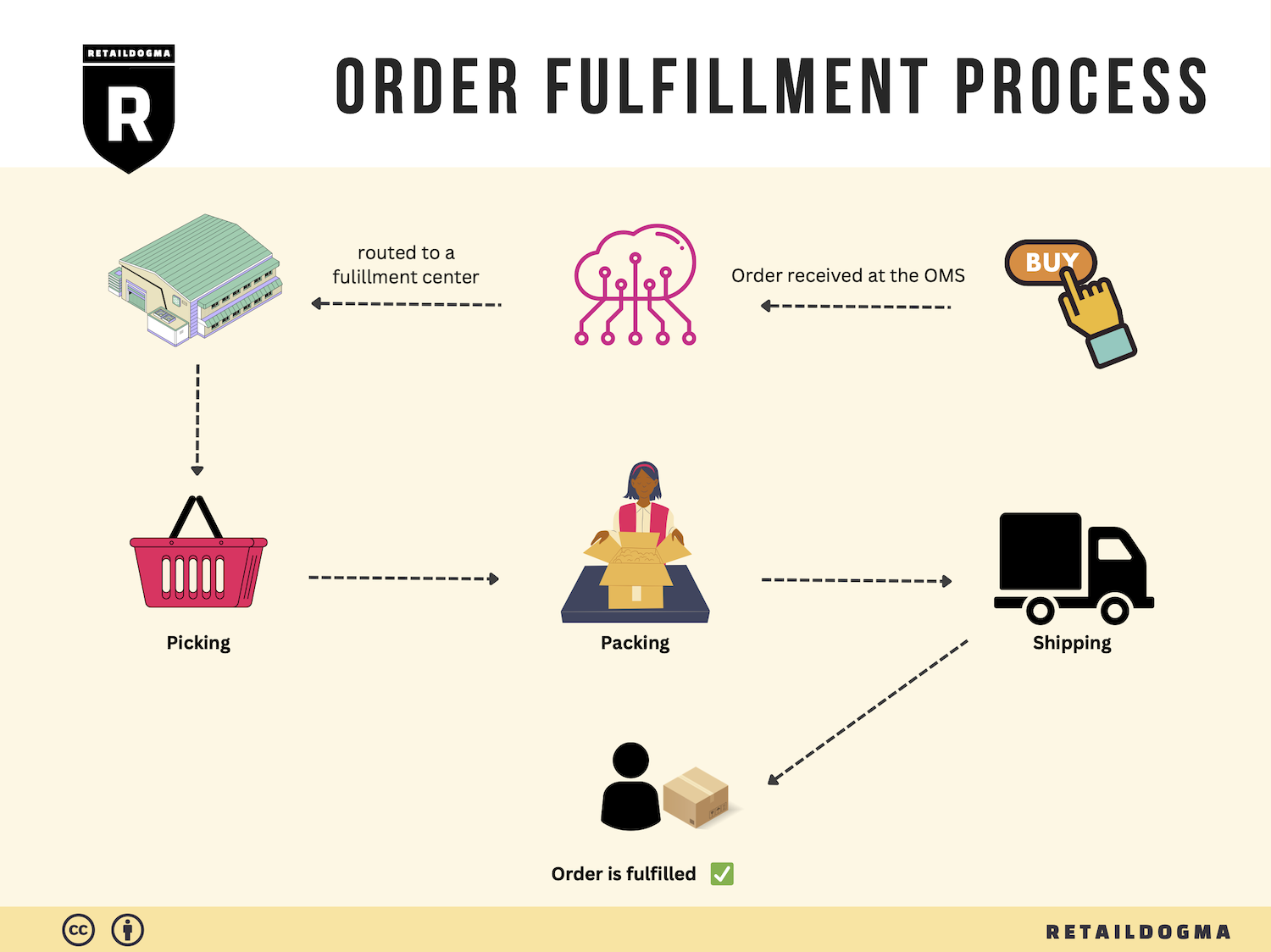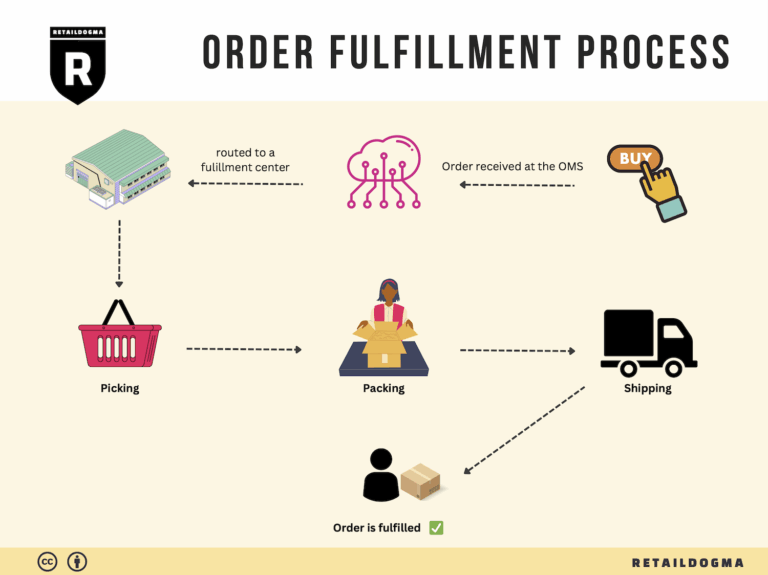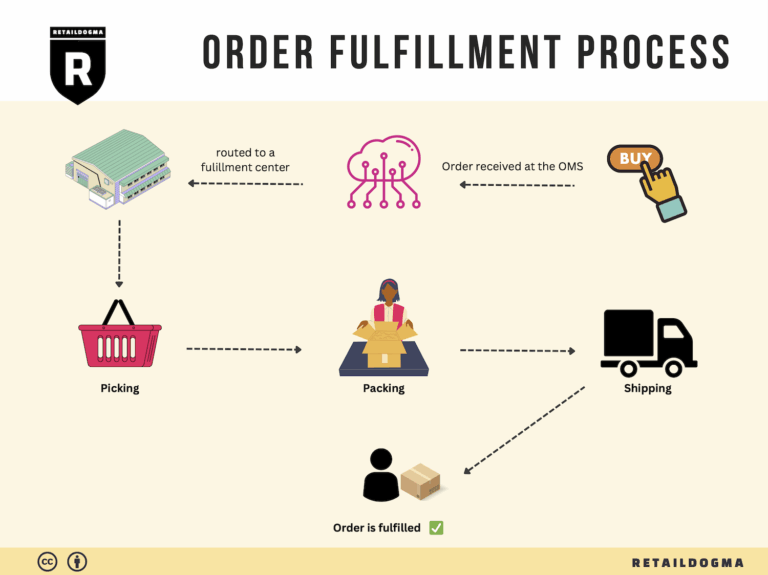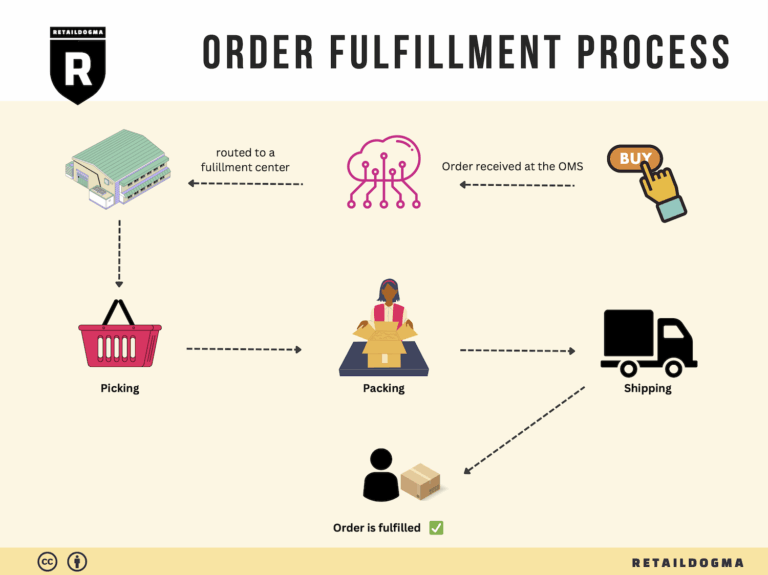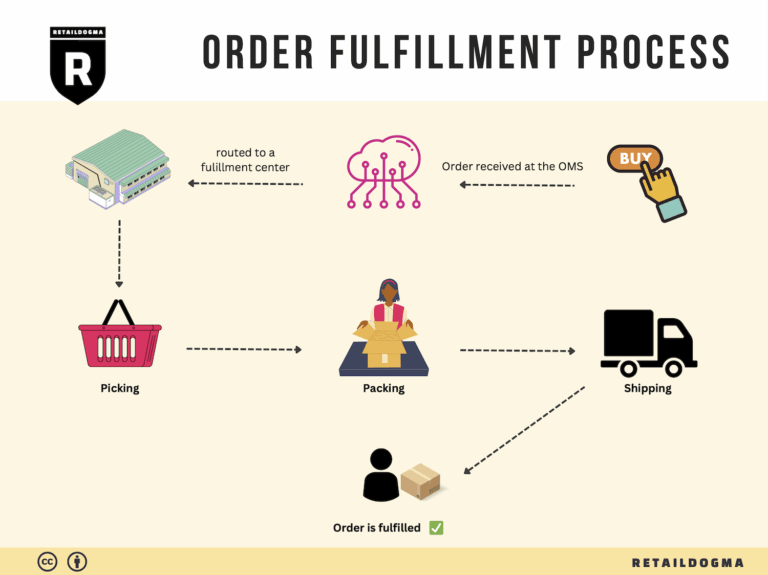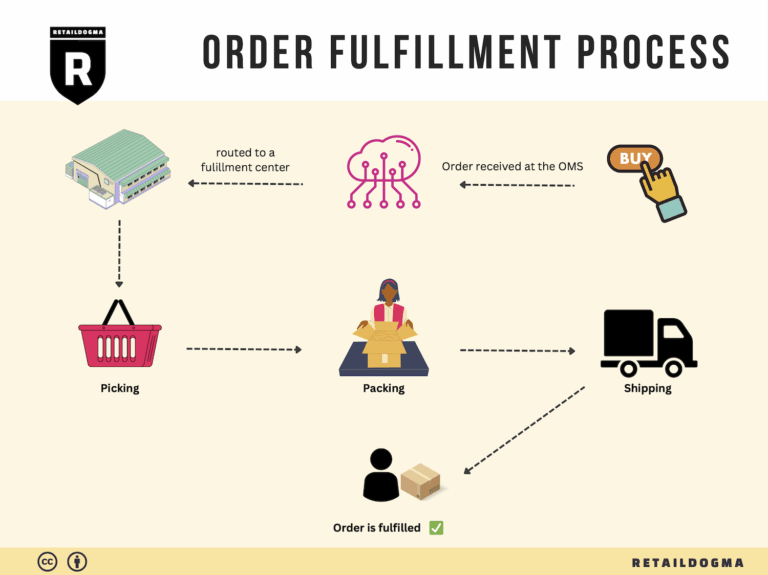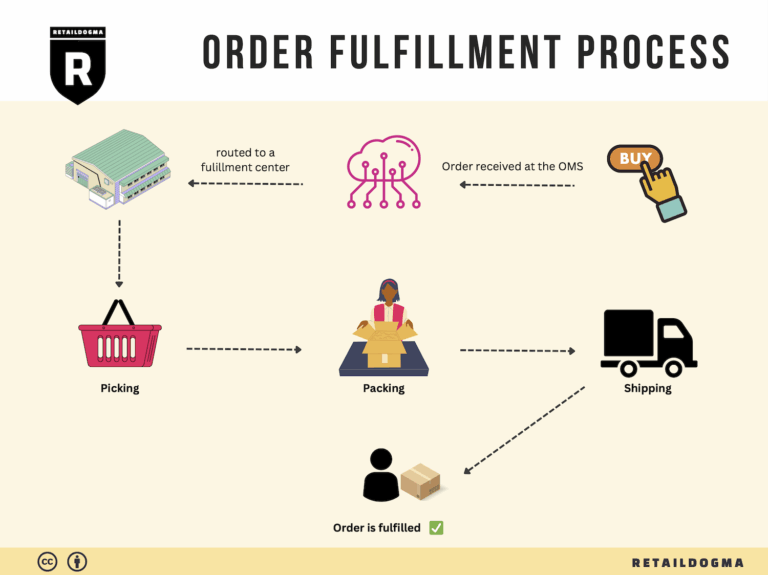How Order Fulfillment Works: A Step-by-Step Guide for Businesses
What is E-commerce Fulfillment? An Introduction for Growing Businesses
The Challenge of Order Fulfillment for Growing Online Businesses
As an e-commerce business owner, you may find yourself facing a common yet significant challenge: the overwhelming task of packing and shipping orders. The excitement of growing sales can quickly turn into stress as you juggle inventory management, order processing, and customer service. This is where e-commerce fulfillment comes into play, serving as a critical backbone for your operations. Simply put, fulfillment is the process of getting a product from your warehouse to your customer’s doorstep, ensuring that they receive the right item in a timely manner.
Understanding E-commerce Fulfillment
In this guide, we will delve into the multifaceted world of e-commerce fulfillment, exploring essential topics that can help you streamline your logistics and enhance customer satisfaction. We will discuss various fulfillment models, including Third-Party Logistics (3PL) and Fulfillment by Amazon (FBA), each offering unique advantages tailored to different business needs.
You’ll learn about the core services that fulfillment partners typically offer, such as inventory management, order picking and packing, shipping, and returns processing. These services are designed to simplify your logistics, allowing you to focus more on scaling your business and less on operational headaches.
Choosing the Right Fulfillment Partner
Selecting the right fulfillment partner can be a daunting task. We will provide practical tips on what to look for when evaluating potential partners, including their technology capabilities, service offerings, and customer support. Additionally, understanding pricing structures and how they align with your business model is crucial for maintaining profitability while providing exceptional service.
Empowering Your Business Decisions
Ultimately, the goal of this guide is to empower you to make informed decisions about your logistics. By understanding the ins and outs of e-commerce fulfillment, you can strategically position your business for growth, enhance customer experiences, and streamline your operations. Whether you’re just starting or looking to optimize an existing fulfillment strategy, this guide will serve as a comprehensive resource to navigate the complexities of e-commerce fulfillment effectively.
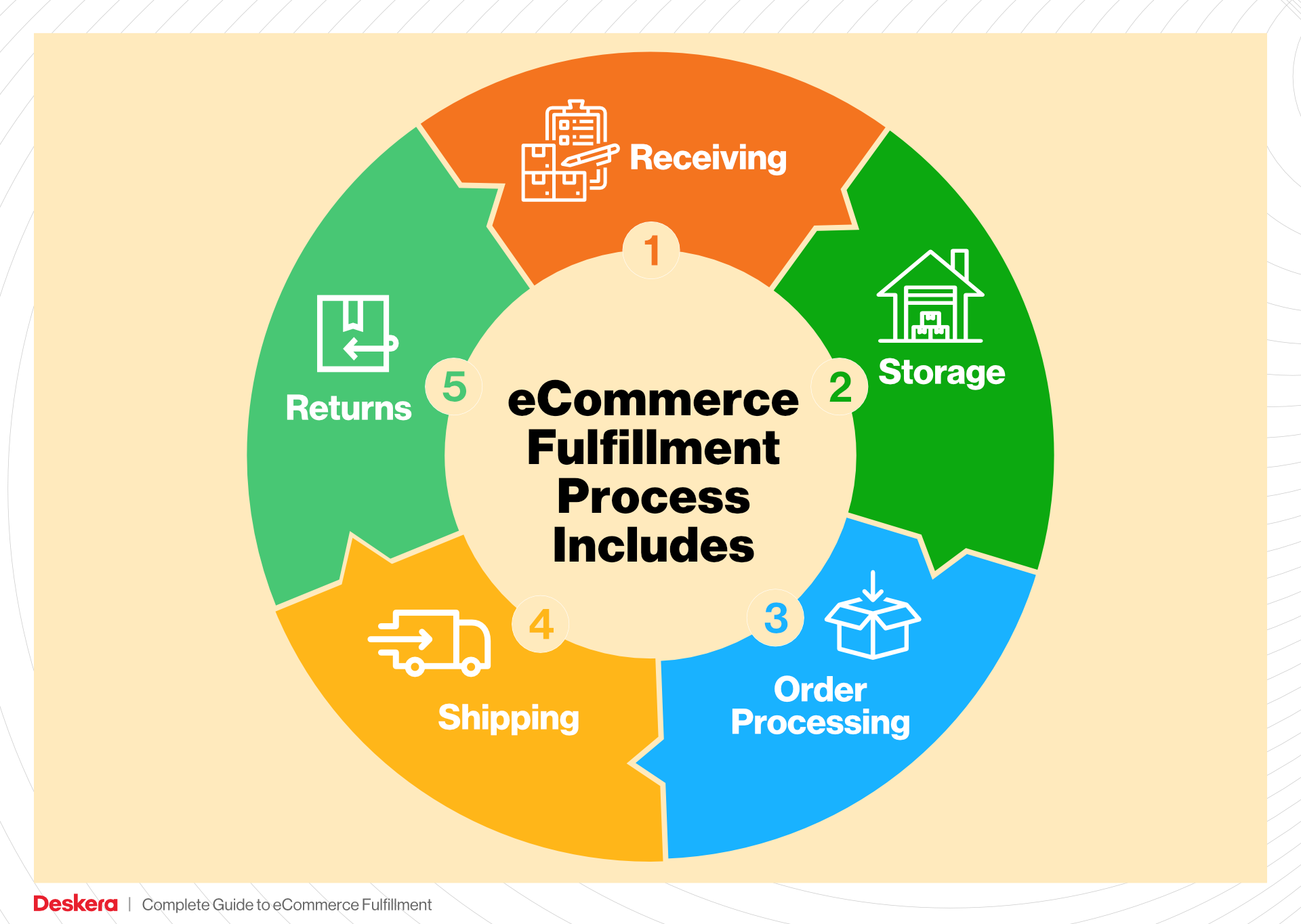
Join us as we explore how to transform your fulfillment process into a competitive advantage for your growing online business.
What You’ll Learn In This Guide
- What is E-commerce Fulfillment? An Introduction for Growing Businesses
- The Order Fulfillment Process: From ‘Buy’ Button to Customer’s Door
- Comparing Fulfillment Models: In-House vs. 3PL vs. Dropshipping
- A Deep Dive into Amazon FBA: Pros, Cons, and Who It’s For
- Core Services Offered by Fulfillment Centers
- How to Choose a Fulfillment Partner: A 6-Point Checklist
- Understanding Fulfillment Pricing: A Breakdown of Common Fees
- Frequently Asked Questions (FAQs) about Fulfillment
- Conclusion: Is Outsourcing Fulfillment the Right Move for Your Business?
- Important Disclaimer
The Order Fulfillment Process: From ‘Buy’ Button to Customer’s Door
1. Receiving Inventory
The first step in the order fulfillment process begins with receiving inventory from suppliers. During this phase, products are checked against purchase orders to ensure accuracy in quantity and quality. This is crucial for maintaining inventory accuracy and preventing stock discrepancies. Key terms associated with this step include Stock Keeping Unit (SKU) and receiving reports. An SKU is a unique identifier for each product, allowing for efficient tracking and management of inventory levels.
Proper receiving procedures help identify any discrepancies early on, allowing businesses to address issues before they affect customer orders. Efficient inventory receiving not only streamlines operations but also sets the foundation for accurate inventory control, which is essential for meeting customer demands in a timely manner.
2. Warehouse Storage
Once inventory is received, the next step is warehouse storage. This involves organizing products in a manner that maximizes space while facilitating easy access. Effective warehouse storage strategies often utilize techniques such as FIFO (First In, First Out) or LIFO (Last In, First Out) depending on the nature of the products. Key terms here include bin locations and inventory management systems (IMS).
Proper storage is vital because it influences the efficiency of subsequent steps in the fulfillment process. By strategically placing high-demand items closer to shipping areas and using an IMS for real-time tracking, businesses can reduce picking times and improve overall operational efficiency. This organization also aids in inventory audits and helps prevent losses due to misplacement or theft.
3. Order Picking
Order picking is the process of retrieving items from storage to fulfill customer orders. This step often utilizes pick lists—documents that outline the specific items and quantities needed for each order. Effective picking strategies, such as zone picking or wave picking, can significantly enhance speed and accuracy.
The importance of this step lies in its direct impact on customer satisfaction. Errors in picking can lead to incorrect orders, resulting in returns and unhappy customers. By implementing technology such as barcode scanners or pick-to-light systems, businesses can reduce human error and improve picking efficiency. Accurate order picking ensures that customers receive the correct products on time, which is crucial for building brand loyalty.
4. Order Packing
After items are picked, the next step is order packing. During this phase, products are securely packaged to prevent damage during transit. Packing materials such as bubble wrap, packing peanuts, and custom boxes are often used to ensure products are well-protected. Key terms associated with this step include packing slips and branded packaging.
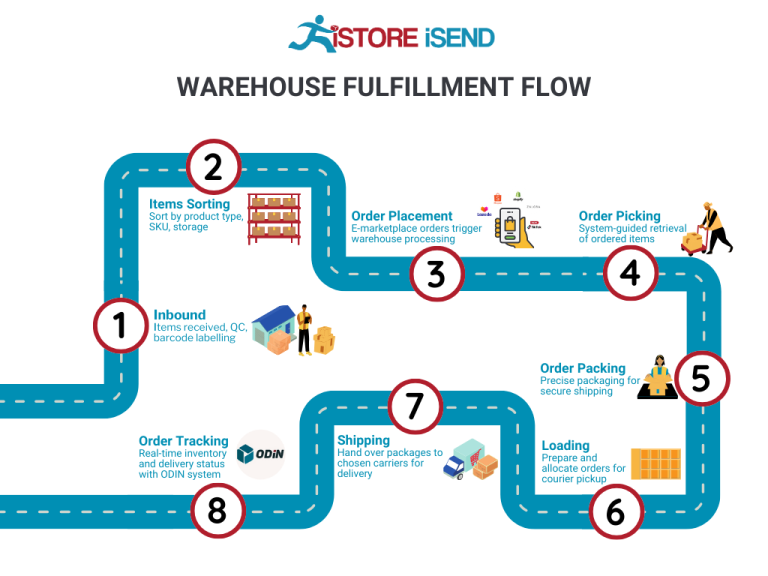
Order packing is essential not only for protecting products but also for enhancing the customer experience. A well-packed order can create a positive impression and reduce the likelihood of returns due to damage. Additionally, including packing slips helps customers verify their orders, while branded packaging can serve as a marketing tool, reinforcing brand identity. Efficient packing processes can also help minimize shipping costs by optimizing package size and weight.
5. Shipping & Delivery
The final step in the order fulfillment process is shipping and delivery. This involves selecting the most efficient shipping method based on factors such as cost, speed, and customer preferences. Key terms in this step include shipping carriers and tracking numbers.
Shipping and delivery are critical because they determine how quickly customers receive their orders. In today’s e-commerce landscape, customers expect fast and reliable delivery options, and failure to meet these expectations can lead to lost sales and damaged reputation. By partnering with reliable shipping carriers and utilizing tracking systems, businesses can provide customers with real-time updates on their order status. Efficient shipping not only improves customer satisfaction but also enhances operational efficiency, ultimately contributing to business growth.
By understanding and optimizing each of these five steps in the order fulfillment process, e-commerce businesses can effectively manage their logistics, improve customer satisfaction, and scale their operations successfully.
Comparing Fulfillment Models: In-House vs. 3PL vs. Dropshipping
Fulfillment Model Comparison
| Model | Who Handles Inventory | Best For (Business Stage) | Key Advantage | Key Disadvantage |
|---|---|---|---|---|
| In-House Fulfillment | Business (Owner/Staff) | Startups to Mid-Sized Companies | Complete control over inventory and processes | High overhead costs and resource-intensive |
| Third-Party Logistics (3PL) | 3PL Provider | Growing and Established Businesses | Scalability and access to advanced logistics | Less control over fulfillment processes |
| Dropshipping | Supplier/Manufacturer | Startups and Small Businesses | Low upfront investment and risk | Lower profit margins and dependency on suppliers |
In-House Fulfillment
In-house fulfillment involves managing the entire logistics process within your own business. This includes storing inventory, processing orders, picking, packing, and shipping products directly to customers. This model is often favored by startups and mid-sized companies that want to maintain full control over their operations. The key advantage of in-house fulfillment is the ability to oversee every aspect of the supply chain, from inventory management to customer service, allowing for tailored customer experiences and immediate responsiveness to issues. However, this model comes with significant overhead costs, as it requires investment in warehouse space, staff, and technology. For many businesses, the resource-intensive nature of in-house fulfillment can divert attention from core business activities, such as marketing and product development, potentially hindering growth.
Third-Party Logistics (3PL)
Third-party logistics (3PL) providers offer a comprehensive range of services that include warehousing, inventory management, order fulfillment, and shipping. Partnering with a 3PL is often the best choice for growing and established businesses that require scalable solutions to meet increased demand. One of the primary advantages of using a 3PL is the ability to leverage their expertise, technology, and established networks to streamline logistics operations and reduce shipping times. This can lead to improved customer satisfaction and lower operational costs. However, relying on a 3PL means that businesses may have less control over the fulfillment process, which can lead to potential issues with inventory accuracy, order fulfillment speed, and customer communication. It’s crucial for businesses to choose a reputable 3PL partner and maintain clear communication to mitigate these risks.
Dropshipping
Dropshipping is a fulfillment model where the retailer does not keep the products it sells in stock. Instead, when a customer places an order, the retailer purchases the item from a third-party supplier, who then ships the product directly to the customer. This model is particularly appealing to startups and small businesses due to its low upfront investment and minimal risk. Since retailers do not need to invest in inventory or warehousing, they can focus their resources on marketing and customer acquisition. However, dropshipping does come with its own set of challenges. Profit margins are typically lower compared to other fulfillment methods, as retailers must pay the supplier’s price while adding their markup. Additionally, retailers are reliant on suppliers for product quality, stock levels, and shipping times, which can affect customer satisfaction if not managed properly. Therefore, while dropshipping can be a low-risk entry point into e-commerce, it requires careful supplier selection and management to ensure a positive customer experience.
Conclusion
Choosing the right fulfillment model depends on various factors including business size, growth stage, and operational capabilities. In-house fulfillment offers control and customization but can be costly and labor-intensive. Third-party logistics provide scalability and expertise, making them ideal for growing businesses, while dropshipping offers a low-risk entry point into e-commerce but may lead to lower profit margins and quality control issues. Each model has its own advantages and challenges, and understanding these will help e-commerce business owners make informed decisions as they scale their operations.
A Deep Dive into Amazon FBA: Pros, Cons, and Who It’s For
Understanding Fulfillment by Amazon (FBA)
Fulfillment by Amazon (FBA) is a service offered by Amazon that allows sellers to store their products in Amazon’s fulfillment centers. In this model, Amazon takes on the responsibility of storing inventory, packing products, and shipping them directly to customers. Sellers benefit from Amazon’s extensive logistics network, customer service, and the ability to leverage Amazon’s marketplace for greater visibility and sales potential.
How FBA Works
-
Registration and Setup: Sellers first create an Amazon seller account and enroll in the FBA program. They then prepare their products according to Amazon’s guidelines, including labeling and packaging requirements.
-
Shipping Inventory to Amazon: Once products are prepared, sellers ship their inventory to one or more of Amazon’s fulfillment centers. Amazon provides shipping plans to help sellers manage this process efficiently.
-
Storage and Management: Once the products arrive at the fulfillment center, they are stored until an order is placed. Amazon’s inventory management system allows sellers to track stock levels and sales performance.
-
Order Fulfillment: When a customer places an order, Amazon takes care of picking, packing, and shipping the product. This process is typically very quick, often resulting in same-day or next-day delivery.
-
Customer Service and Returns: Amazon also manages customer service inquiries and returns for FBA orders, providing a seamless experience for buyers.
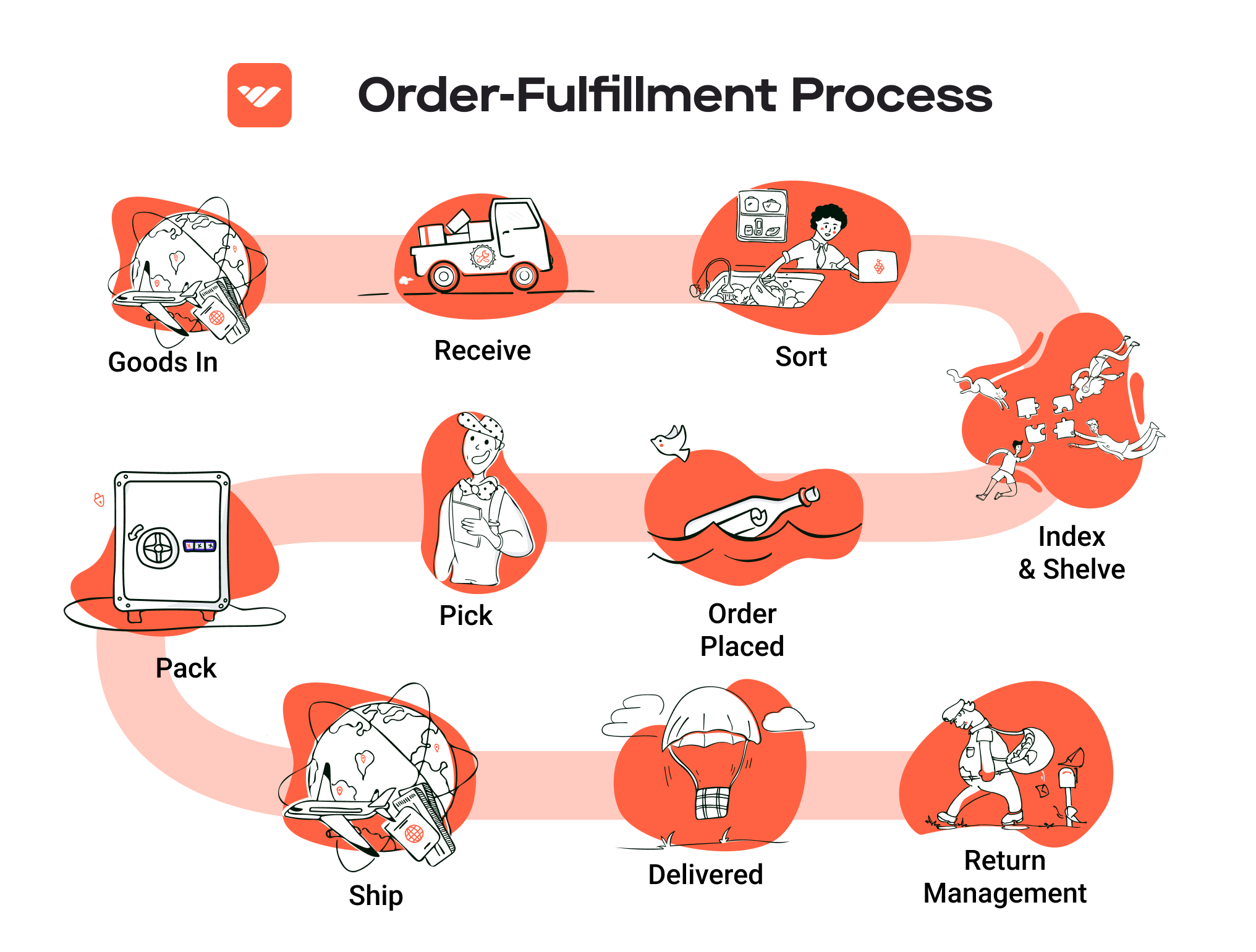
Pros of Using FBA
-
Prime Eligibility: Products fulfilled by Amazon are eligible for Amazon Prime, which can significantly increase sales. Prime members often prefer items that offer fast and free shipping, making FBA an attractive option for sellers aiming to tap into this customer base.
-
Customer Trust: Leveraging Amazon’s brand and reputation can enhance customer trust. Buyers are more likely to purchase from sellers who use FBA, as they associate Amazon with reliability and quality service.
-
Multi-Channel Fulfillment: FBA allows sellers to fulfill orders from various sales channels, not just Amazon. This means that sellers can use FBA to manage inventory and shipping for orders coming from their own websites or other marketplaces, streamlining operations.
-
Scalability: FBA provides businesses with the ability to scale quickly without the need to invest heavily in logistics and warehousing. Sellers can focus on growing their business while Amazon manages the logistics.
-
Streamlined Operations: By outsourcing fulfillment to Amazon, sellers can save time and resources that would otherwise be spent on packing and shipping. This allows them to concentrate on marketing, product development, and customer engagement.
Cons of Using FBA
-
High Fees: FBA can be costly. Sellers incur various fees, including storage fees for unsold inventory and fulfillment fees based on the size and weight of products. These costs can eat into profit margins, particularly for low-priced items.
-
Strict Inventory Rules: Amazon has strict guidelines regarding inventory management, including limits on storage and the requirement for products to meet specific conditions. Sellers must stay compliant to avoid penalties or account suspension.
-
Commingling Risks: FBA can lead to commingling of inventory, where products from different sellers are stored together. This can create issues if there are quality concerns or if a seller receives returns of a different seller’s products, potentially impacting brand reputation.
-
Loss of Control: When using FBA, sellers relinquish some control over the fulfillment process. This includes aspects such as packaging and shipping speed, which can vary depending on Amazon’s operational capabilities.
-
Complex Returns Management: While Amazon handles returns for FBA orders, the process can sometimes be complicated for sellers. They may have limited visibility into the return process, making it harder to manage customer relationships effectively.
Who is FBA Best For?
Fulfillment by Amazon is particularly suited for:
-
Small to Medium-Sized Businesses: Businesses that are looking to scale quickly without the overhead costs associated with managing logistics and warehousing can greatly benefit from FBA.
-
E-commerce Entrepreneurs: Individuals starting out in e-commerce who want to leverage Amazon’s infrastructure for visibility and sales can find FBA to be a low-risk way to enter the market.
-
Sellers with High Turnover Products: Businesses that sell products with high demand and quick turnover will find FBA advantageous due to the speed of fulfillment and access to Prime customers.
-
Brands Seeking Trust and Visibility: Companies looking to enhance their brand presence on Amazon and gain customer trust can leverage FBA to make their products more appealing to buyers.
-
Multi-Channel Sellers: Businesses selling on multiple platforms can use FBA to simplify order fulfillment across different channels while benefiting from Amazon’s logistics capabilities.
In conclusion, while Fulfillment by Amazon offers numerous advantages that can help businesses scale and succeed in the competitive e-commerce landscape, it is essential for sellers to weigh the pros and cons carefully. Understanding the operational intricacies and financial implications of FBA will enable sellers to make informed decisions that align with their business goals.
Core Services Offered by Fulfillment Centers
Inventory Management & Warehousing
Effective inventory management and warehousing are foundational components of successful e-commerce fulfillment centers. This service encompasses the systematic tracking, storage, and control of stock levels to ensure that businesses can meet customer demand without overstocking or stockouts.
Fulfillment centers utilize advanced technology, such as Warehouse Management Systems (WMS), to provide real-time visibility into inventory levels. This capability allows e-commerce businesses to forecast demand accurately and make informed decisions regarding restocking and inventory turnover. The benefits of robust inventory management include:
- Reduced Costs: By minimizing excess inventory, businesses can lower storage costs and reduce waste.
- Improved Cash Flow: Maintaining optimal inventory levels ensures that capital is not tied up in unsold goods, allowing for reinvestment in growth opportunities.
- Enhanced Customer Satisfaction: Accurate inventory tracking means that customers are less likely to encounter stockouts, leading to improved trust and loyalty.
Pick and Pack Services
Pick and pack services are critical for ensuring that orders are fulfilled accurately and efficiently. This process involves selecting the right products from the warehouse, packing them securely, and preparing them for shipment. Fulfillment centers often employ specialized staff and automated systems to streamline this process.
The benefits of professional pick and pack services include:
- Speed and Efficiency: Experienced staff and optimized workflows enable quicker order processing, leading to faster shipping times. This is especially crucial in an era where consumers expect rapid delivery.
- Accuracy: Utilizing barcode scanning and other technology reduces the risk of errors in order fulfillment, ensuring that customers receive exactly what they ordered.
- Scalability: As an e-commerce business grows, fulfillment centers can easily scale their pick and pack operations to accommodate increased order volumes without sacrificing quality.
Kitting and Assembly
Kitting and assembly refer to the process of combining multiple products into a single package or kit for distribution. This service is particularly beneficial for e-commerce businesses that offer subscription boxes, promotional bundles, or customized product offerings. Fulfillment centers can manage the assembly of these kits, ensuring that all components are included and packaged according to specifications.
The advantages of kitting and assembly services include:
- Enhanced Customer Experience: Providing customers with bundled products or kits creates added value, making it easier for them to purchase multiple items at once.
- Cost Efficiency: By consolidating multiple products into a single shipment, businesses can reduce shipping costs and packaging waste.
- Branding Opportunities: Customized kits can be branded uniquely, reinforcing brand identity and enhancing customer loyalty.
Returns Management (Reverse Logistics)
Returns management, often referred to as reverse logistics, is an essential service offered by fulfillment centers. It involves the process of handling returns from customers, including inspecting returned items, restocking them, and managing the overall returns process. Efficient returns management is vital in today’s e-commerce landscape, where return rates can be significant, especially in sectors like fashion and electronics.
The benefits of effective returns management include:
- Customer Retention: A hassle-free return process enhances customer satisfaction and encourages repeat purchases. Customers are more likely to shop with brands that offer easy returns.
- Data Insights: Analyzing return patterns can provide valuable insights into product performance and customer preferences, enabling businesses to make informed decisions about inventory and product offerings.
- Cost Control: Streamlining the returns process can reduce the costs associated with handling returns, such as shipping and restocking, ultimately improving the bottom line.
Conclusion
In summary, fulfillment centers offer a comprehensive suite of services that are crucial for e-commerce businesses looking to scale their operations efficiently. From inventory management and warehousing to pick and pack services, kitting and assembly, and returns management, these services not only streamline logistics but also enhance customer satisfaction and drive growth. By partnering with a reliable fulfillment center, e-commerce businesses can focus on their core competencies while ensuring that their logistics operations run smoothly and effectively.
How to Choose a Fulfillment Partner: A 6-Point Checklist
Location & Warehouse Network
The geographical location of your fulfillment partner is crucial to ensuring efficient and timely delivery to your customers. A strategically located warehouse network can significantly reduce shipping times and costs, enhancing customer satisfaction.
Why It Matters:
– Proximity to Customers: A fulfillment center located closer to your primary customer base can speed up delivery times, which is increasingly important in the age of same-day and next-day shipping expectations.
– Shipping Costs: Reducing distance means lower shipping fees, which can affect your bottom line and pricing strategy.
Questions to Ask:
– Where are your fulfillment centers located, and what is the coverage area?
– How do you determine the best shipping methods and carriers for my products?
– Can you handle international shipping, and what are your capabilities in this area?
Technology & Integrations
In today’s digital age, technology plays a pivotal role in the efficiency of fulfillment operations. The right technology can streamline processes, enhance inventory management, and provide real-time visibility into your supply chain.
Why It Matters:
– Real-Time Tracking: Advanced systems allow for real-time tracking of inventory and shipments, which enhances transparency and customer experience.
– Integration Capabilities: Your fulfillment partner should seamlessly integrate with your e-commerce platforms and other software tools to minimize manual processes.
Questions to Ask:
– What Warehouse Management System (WMS) do you use, and how does it integrate with my e-commerce platform?
– Can you provide real-time tracking for shipments, and how will I access this information?
– Do you offer API support for custom integrations with my existing systems?
Specializations (e.g., Cold Storage, Oversized Items)
Different businesses have unique requirements based on the types of products they sell. Understanding your potential partner’s specializations is essential for ensuring they can meet your specific needs.
Why It Matters:
– Product Suitability: If you deal with perishable goods, oversized items, or fragile products, your fulfillment partner must have the necessary facilities and expertise to handle these items correctly.
– Quality Assurance: Specialized handling can help prevent damage and maintain product integrity.
Questions to Ask:
– What specializations does your fulfillment center offer (e.g., cold storage, hazardous materials)?
– How do you handle products that require specific storage conditions?
– Can you accommodate seasonal fluctuations in product types and volumes?
Scalability & Capacity
As your business grows, so will your fulfillment needs. Your chosen partner should be able to scale operations in line with your growth trajectory without compromising service quality.
Why It Matters:
– Flexibility: A scalable partner can adjust to your changing order volumes, especially during peak seasons, ensuring that you do not miss out on sales opportunities.
– Long-Term Partnership: Choosing a partner with scalable solutions means you won’t have to switch providers as your business expands.
Questions to Ask:
– What is your current capacity, and how do you plan to accommodate growth?
– Can you handle seasonal spikes in demand, and what is your process for ramping up operations?
– What measures do you have in place to ensure that your service quality remains high during peak times?
Pricing and Contracts
Understanding the pricing structure and contractual obligations is crucial for budgeting and financial forecasting. Transparency in pricing will help you avoid unexpected costs that can impact your margins.
Why It Matters:
– Cost Management: Knowing all associated costs (e.g., storage, shipping, handling) allows for better financial planning.
– Contract Flexibility: A flexible contract can provide the freedom to adapt to changing business needs without facing penalties.
Questions to Ask:
– Can you provide a detailed breakdown of your pricing structure?
– Are there any hidden fees I should be aware of (e.g., for returns, storage, or peak season)?
– What are the terms of the contract, and is there flexibility for renegotiation as my business needs change?
Customer Support & Reviews
Strong customer support can be a significant differentiator between fulfillment partners. Additionally, reviews and testimonials can provide insights into the partner’s reliability and service quality.
Why It Matters:
– Responsive Support: Quick and effective customer support can resolve issues before they escalate, maintaining a smooth operation.
– Reputation and Trust: Reviews can give you a sense of the partner’s track record and how they handle challenges.
Questions to Ask:
– What customer support options are available (e.g., phone, chat, email)?
– What is your average response time for inquiries or issues?
– Can you provide references or case studies from current or past clients?
Conclusion
Choosing the right fulfillment partner is a strategic decision that can significantly impact your e-commerce business’s success. By carefully evaluating potential partners based on location, technology, specializations, scalability, pricing, and customer support, you can make an informed choice that aligns with your business goals and enhances your operational efficiency. Take the time to ask the right questions and conduct thorough due diligence to ensure a successful partnership that can grow with your business.
Understanding Fulfillment Pricing: A Breakdown of Common Fees
Initial Setup Fees
When partnering with a fulfillment center, businesses often encounter initial setup fees. These costs cover the onboarding process, which includes integrating your e-commerce platform with the fulfillment provider’s systems, initial inventory counts, and configuration of your account settings.
Typically, initial setup fees can range from a few hundred to several thousand dollars, depending on the complexity of your operations and the level of customization required. Some providers may offer promotional waivers for these fees, especially for long-term contracts or high-volume clients. It’s essential to clarify what is included in the setup process to avoid unexpected costs.
Receiving Fees
Receiving fees are charged when your inventory arrives at the fulfillment center. These fees cover the labor and resources needed to unload, inspect, and inventory your products. The calculation for receiving fees can vary widely based on factors such as the size and weight of the shipment, the number of items received, and the complexity of the receiving process.
Typically, fulfillment centers may charge a flat fee per shipment or a variable fee based on the total weight or volume of the products. Businesses should inquire about how these fees are structured and look for providers that offer transparency in their pricing models to avoid surprises.
Storage Fees (per pallet/bin)
Storage fees are incurred for keeping your inventory at the fulfillment center. These fees are usually calculated on a per pallet or per bin basis, depending on how your products are stored. The cost can vary based on the location of the warehouse, the size of the pallets, and the duration of storage.
For example, businesses might pay a monthly fee per pallet, which can range from $10 to $25, or a bin fee that is lower for smaller items. It’s crucial to monitor your inventory levels and turnover rates, as prolonged storage can lead to increased costs. Some fulfillment centers also offer tiered pricing models, where the cost per pallet decreases as the volume of stored goods increases, encouraging businesses to maintain higher inventory levels.
Pick & Pack Fees (per item/order)
Pick and pack fees are among the most significant costs in the fulfillment process. These fees are charged for the labor involved in picking items from the warehouse shelves and packing them for shipment. Typically, the fee is calculated on a per item or per order basis.
For instance, a fulfillment center may charge $1 to $3 per item picked and packed, with discounts for larger orders. Understanding the nuances of these fees is essential, as additional charges may apply for special packing requests, such as gift wrapping or custom packaging. To optimize costs, businesses should consider product assortment and order size, as bulk orders can often reduce the per-item fee.
Shipping Fees
Shipping fees are the final piece of the fulfillment pricing puzzle and can vary significantly based on several factors, including the shipping method (standard, expedited, or same-day), the destination, and the weight and dimensions of the package.
Fulfillment centers typically negotiate shipping rates with carriers and pass these costs on to their clients. Businesses should expect to see shipping fees broken down by carrier and service level, allowing for better budget forecasting. Some fulfillment providers offer flat-rate shipping options or discounts for high-volume shippers, which can be advantageous for businesses with consistent order patterns.
Tips for Getting an Accurate Quote
To secure an accurate quote for fulfillment services, consider the following steps:
-
Detail Your Needs: Clearly outline your inventory volume, order frequency, product types, and any special requirements (like kitting or custom packaging). This information helps fulfillment providers tailor their quotes to your specific needs.
-
Compare Multiple Providers: Don’t settle for the first quote you receive. Reach out to several fulfillment centers and compare their pricing structures, services, and overall value. Pay attention to hidden fees that may not be immediately apparent.
-
Ask About Volume Discounts: Inquire if there are discounts available for higher volumes of orders or long-term contracts. This can lead to significant savings.
-
Clarify Terms and Conditions: Ensure you fully understand the terms of service, including cancellation policies, service level agreements, and what happens if your order volumes fluctuate.
-
Negotiate: Don’t hesitate to negotiate terms or fees. Many fulfillment centers are willing to adjust pricing for potential long-term partnerships.
By understanding these common fees and how they are calculated, e-commerce businesses can better navigate the complexities of fulfillment pricing and make informed decisions that support their growth objectives.
Frequently Asked Questions (FAQs) about Fulfillment
1. What is fulfillment in e-commerce?
Fulfillment in e-commerce refers to the entire process of receiving, processing, and delivering customer orders. This includes inventory management, order picking and packing, shipping, and handling returns. Effective fulfillment is critical for customer satisfaction and can significantly impact your business’s reputation and growth.
2. What is a fulfillment center?
A fulfillment center is a specialized warehouse where products are stored, packed, and shipped to customers. Unlike traditional warehouses, which primarily focus on storage, fulfillment centers are designed to streamline the order processing and shipping process, ensuring faster delivery times and enhanced customer service.
3. What is the difference between a warehouse and a fulfillment center?
The primary difference lies in their purpose. A warehouse is primarily used for storing goods until they are needed, while a fulfillment center focuses on processing and shipping orders directly to customers. Fulfillment centers are equipped with advanced technology to manage inventory, track orders, and expedite shipping, making them essential for e-commerce operations.
4. What is a 3PL (Third-Party Logistics)?
A 3PL is a service provider that manages a company’s logistics operations, including warehousing, fulfillment, and shipping. By outsourcing these functions to a 3PL, businesses can focus on core activities such as marketing and sales while leveraging the expertise of logistics professionals to enhance efficiency and reduce costs.
5. How do I choose the right fulfillment partner in Appleton?
When selecting a fulfillment partner in Appleton, consider factors such as their experience in your industry, the technology they use for order management, shipping capabilities, and their customer service reputation. It’s also essential to evaluate their scalability to ensure they can accommodate your growth needs.
6. How much do fulfillment services cost?
Fulfillment service costs can vary widely based on several factors, including the volume of orders, storage space required, packaging needs, and shipping methods. Generally, fees may include a per-order fee, storage fees, and additional charges for services like kitting or returns management. It’s advisable to request quotes from multiple providers to compare pricing structures.
7. What technologies are used in fulfillment centers?
Fulfillment centers utilize various technologies, including Warehouse Management Systems (WMS), inventory tracking software, automated picking systems, and shipping management tools. These technologies enhance efficiency, reduce errors, and provide real-time visibility into inventory levels and order statuses.
8. How can I improve my fulfillment process?
To improve your fulfillment process, consider implementing technology solutions for inventory management, optimizing warehouse layout for efficient picking and packing, and establishing clear communication channels with your fulfillment partner. Regularly reviewing and analyzing fulfillment metrics can also help identify areas for improvement.
9. What are the benefits of using a fulfillment center?
Using a fulfillment center offers numerous benefits, including reduced overhead costs, improved order accuracy, faster shipping times, and the ability to scale operations quickly. It also allows businesses to focus on core competencies while leveraging the expertise of logistics professionals.
10. How do returns work in fulfillment?
Returns management in fulfillment typically involves a streamlined process where customers can easily return products. Fulfillment centers handle the logistics of receiving returned items, inspecting them, and restocking them as necessary. Many providers offer automated returns solutions that provide customers with return labels and track the return process, enhancing customer satisfaction.
Conclusion: Is Outsourcing Fulfillment the Right Move for Your Business?
Evaluating the Benefits of Outsourcing Fulfillment
Outsourcing fulfillment can be a game-changer for e-commerce businesses aiming to scale effectively. By partnering with a dedicated fulfillment service, you can save valuable time that would otherwise be spent on logistics management. This allows you to redirect your focus toward strategic growth initiatives, such as enhancing your product offerings or expanding your marketing efforts.
Moreover, fulfillment services provide the scalability that growing businesses often require. As order volumes fluctuate, a reliable partner can seamlessly adjust to your changing needs, ensuring that you never miss an opportunity to satisfy customer demand. This flexibility is particularly crucial during peak seasons or promotional events when order volumes can surge unexpectedly.
Additionally, these fulfillment centers bring specialized expertise to the table. With years of experience and advanced technology, they streamline processes, enhance accuracy in order picking and packing, and reduce shipping times. This not only boosts customer satisfaction but also strengthens your brand reputation in a competitive market.
However, it is critical to choose the right fulfillment partner. Not all providers offer the same level of service, and aligning with a partner that understands your business model and industry nuances can significantly impact your operational efficiency and customer experience.
Next Steps
To determine if outsourcing fulfillment is the right move for your business, conduct a thorough audit of your current shipping processes. Assess your order volume, shipping times, and customer feedback. This evaluation will provide clarity on whether a fulfillment partner can elevate your operations and support your growth ambitions. If you find gaps in your current setup, consider reaching out to fulfillment experts to explore tailored solutions that align with your business goals. Taking this strategic step could be the key to unlocking your business’s full potential.
Important Disclaimer
⚠️ Important Disclaimer
The information in this guide is for educational purposes. Fulfillment services, pricing, and platform features change frequently. Always conduct your own due diligence and consult with providers directly before making business decisions.
